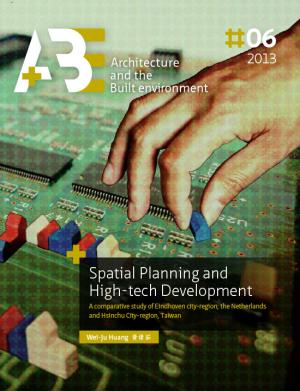Hosted by
Spatial Planning and High-tech Development: A comparative study of Eindhoven city-region, the Netherlands and Hsinchu City-region, Taiwan
Synopsis
High-tech development–which lies at the very heart of the processes of economic growth–has been recognised by many developed and developing countries as a strategic instrument to enhance and sustain their competitiveness in the global economic network. Although the concept of high-tech development differs between countries, many share the underlying assumption that the core of high-tech development is to create a sound environment where innovation thrives. This ideology implies a definite spatial dimension. As a result, various spatial strategies have been formulated and implemented to support high-tech development. This has had intentional and unintentional effects on the economy, society and space.
Numerous studies have been devoted to exploring, analysing and theorising this global phenomenon. However, there has been less attention given to the role spatial planning may play in the process of high-tech development and to the factors that shape the spatial planning approaches to high-tech development in a particular place. The major objectives of this research are to advance the knowledge of the role of spatial planning in the process of high-tech development, and to establish an analytical framework that helps reveal the major institutional factors that shape spatial planning mechanisms for dealing with the spatial issues of high-tech development in different places. This contributes to the field of high-tech spatial policies transfer and lesson-drawing.
In order to explore the major factors that shape the practices of spatial planning in hightech development, a comparative approach is applied in this research. The Eindhoven city-region in the Netherlands and the Hsinchu city-region in Taiwan are selected as case study areas. Both city-regions can be recognised as success stories of high-tech development not only on a national scale but also on a global scale, despite the fact that they apply different approaches. In the Eindhoven city-region, the governments act as supporters and governors. High-tech development in the city-region is a result of close collaboration between different levels of government and other parties. In contrast, in the Hsinchu city-region the governments act as providers in high-tech development.
By critically reviewing relevant literature, the research begins with the identification of principal components of high-tech development and their spatial dimensions, and with the establishment of a set of comparative frameworks, which are built upon the concepts of institutionalism and previous comparative studies of spatial planning systems. On the basis of the frameworks, the comparative study is conducted. Four major conclusions are drawn in this research.
First, R&D capital, relational capital and human capital can be identified as the principal components of high-tech development, but the conception of the principal components is not static. It may change through time and space, and be influenced by contemporary technological development and dominant discourses about high-tech development. Additionally, how governments in a particular place conceptualise the principal components will influence the content of their strategies for high-tech development.
Second, how governments in a particular place use their spatial planning system and tools to conduct, facilitate and/or coordinate the development of high-tech spaces is influenced by the socio-political context (e.g. model of society, administration system and conceptualisation of rights in land), conceptualisation of the principal components, dominant style of spatial planning, but also by their historical roots and contemporary technological capacities. At the city-regional level, the particular culture characteristics and historical experience of a city-region also have effects on the approach to spatial governance.
Third, it is common that governments recognise the necessity of collaborating with knowledge institutes and high-tech firms in the process of high-tech spatial development, because they have access to a wide range of know-how and crucial resources. The creation of new institutional arenas to invite institutes and firms to participate in the process of decision-making is a good strategy for governments, although they must assure that the decision-making process is transparent and accountable, and meets the principles of social justice.
Finally, the two cases have shown that a successful high-tech spatial development would have spatial effects on the surrounding areas, such as traffic congestion, imbalance between land supply and demand for housing and/or industrial land, and so on. It is necessary to anticipate and monitor continuously the externalities of the development from a more comprehensive perspective and to leave room for adjustment to the spatial planning and governance approaches.
The analytical framework built upon the institutional concepts of Ostrom and Scharpf worked well in this research, but in the process of conducting the empirical study I found that the framework of institutional analysis I established for the empirical study implied a temporarily fixed situation for analysis. Such a framework did create an easier situation for analysis, but proved difficult to use to investigate and explain the dynamic interrelationships between the changing institutional contexts and the decision making of high-tech spatial planning at a specific place and time.
While considering this limitation, I adopted a diachronic approach to complement the empirical study of part three, in order to understand the influences of prior institutional developments and specific episodes on later policy/decision making and action taking. In the future, if other studies consider applying the frameworks of this research, the effect of historical path dependency has to be taken into consideration.

